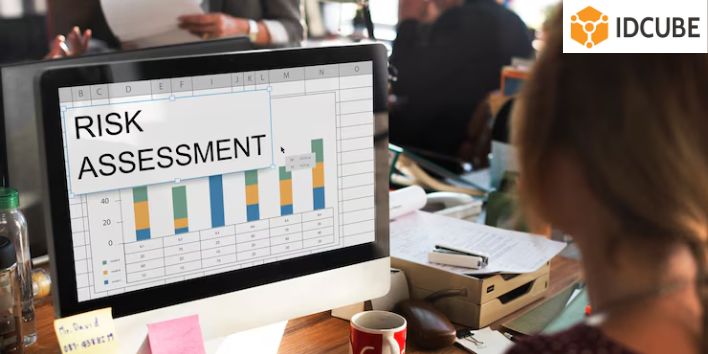
How Enterprise Risk Assessment Software Solves Key Challenges
1. Limited Visibility into Risks
1.1 Description of the Challenge
During enterprise risk assessment if the team lacks visibility of the risks and the awareness of what it actually is looking for, then the whole process is futile. If the company does not have enough risk awareness to start with and there is not much data available for complete risk identification, then the process does not yield ample results.
Siloed data sharing and risk management where the enterprise level risks are handled by certain departments can also lead to limited visibility. In this scenario, all the team members do not have knowledge of the possible risks. This leads to a lack of coordination in decisions and actions needed for risk management.
1.2 How Software Solutions Help
An enterprise risk assessment software resolves the issue of limited visibility by integrating with a central repository. A central database that stores all the data regarding the risks that exist and might come up with time is accessible to all the team members. With valid authorization, a team member of your business can review the risks and understand its impact.
Moreover, the integration of real time risk assessment dashboards maintains transparency in risk assessment and information so that professionals can take risk management decisions quickly. With the help of a transparent software solution, professionals can foster collaboration for better risk management.
2. Inconsistent Risk Management Processes
2.1 Description of the Challenge
When a company is large scale and it has multiple departments, the lack of clear communication is a challenge in proper risk assessment. If the communication channels between different departments do not work, then there could be inconsistent reports of risks between different levels of the same organization.
This Chinese whisper of assessed risks causes problems and delays in timely risk management. If a critical risk comes up and there is inconsistent reporting, there might be insufficient risk management efforts from the collective team. Thus, the risk does not resolve but stays and leads to bigger problems.
2.2 How Software Solutions Help
The use of a good enterprise risk management software ensures that the communication happens smoothly and quickly. The assessment tool notifies the team about any risk present and also analyzes it to suggest ways to resolve the issue at the earliest.
The use of standardized templates for risk reporting and ensuring that the risks are reported on time to all the stakeholders is an important step. With an automated enterprise risk assessment software this is possible as the dashboard is visible to everyone with access. The communication is faster and better which leads to rapid risk management and mitigation on time.
3. Siloed Risk Management Practices
3.1 Description of the Challenge
Siloed risk management happens when the decisions to manage the risks are taken by a few departments and other departments are not as involved. In a siloed management system, the information about the risk and the tasks related to its management trickle down.
This can lead to the entire team not being on the same page and a lot of confusion in the risk management process. The use of a traditional siloed system keeps some people of the organization in the blind and leads to incomplete risk assessment. This leads to fragmented decisions and actions that ultimately do not do anything for the situation.
3.2 How Software Solutions Help
Modern enterprise risk management software does not depend on a siloed system but rather works in an integrated, collaborative manner. The use of a large-scale risk assessment software reports the risk to all the professionals and allows the team to collaborate digitally for risk mitigation.
The enterprise risk management software integrates easily with other business software like marketing platforms, software development platforms and CRM platforms so that professionals can execute actions that mitigate the risk in real time. Decisive actions with the help of different departments at different levels ensures that a strong and quick action for mitigation has been taken.
4. Lack of Executive Buy-In and Support
4.1 Description of the Challenge
When a risk is flagged by an enterprise risk assessment software, there needs to be an unified front against the risk. However, a challenge that businesses face is the lack of cooperation between the senior management and the junior professionals.
The business risk information needs to be with the senior management and it needs to prioritize the risks for quick mitigation. If there is a lack of support from the senior management, it is possible that the risk management strategies do not implement on time. The team might lack the resources needed for risk management when there is not enough support from the senior levels.
4.2 How Software Solutions Help
An enterprise risk assessment software not only screens the risks but also analyzes the kind and impact of the risk with data gathered. The analysis that the software solutions make are accurate and can help rank the risks accordingly. A good risk assessment software shows if the flagged risk is high priority, or is it a minor risk in nature.
The extensive reports and details that the software shares with the team highlights the importance and outcome of the risk. This spreads awareness about the gravity of the risk to the senior leadership so they can mobilize resources for risk mitigation at the earliest.
5. Difficulty in Defining and Quantifying Risks
5.1 Description of the Challenge
When manual risk assessment and management happens, it is possible that the priority of the risk and its kind do not convey properly because of the inconsistency in language. One professional will describe the risk as one and the other will describe it on completely different terms.
Because of the inconsistency in the parameters and standards of the risks in the manual risk detection processes is a challenge. There can be human errors in identifying and quantifying the risks when manual process is followed. This way, a risk does not get reported properly and lacks proper classification which also affects the actions taken for its mitigation.
5.2 How Software Solutions Help
The use of an automated enterprise risk assessment software is an important step as it follows a standardized process and parameters to identify the risks. Because of the standardized parameters, the classification of the risks also happens very easily. A software uses specific tags, language and layout to inform the team about the risks and their seriousness.
A good enterprise risk assessment software is one that defines risks very clearly and categorizes them so that professionals can understand the nature of the risk. A software uses data analysis and scenario analysis processes to quantify the risk and rank them before management.
6. Regulatory Compliance Challenges
6.1 Description of the Challenge
The regulatory and compliance requirements for every company is different depending on which niche it runs in. the regulations and compliance frameworks of different companies should be met when risk assessments are run. With constant evolution of compliance requirements, it is possible that the Enterprise risk assessment processes that are present in an organization become outdated.
The use of outdated processes and tools for risk assessment can yield incorrect results and cause bigger problems for the business. It is important to identify the crucial nature of risk assessment and upgrade to advanced software.
6.2 How Software Solutions Help
To create processes that lead to accurate risk assessment for the company, it is important to use advanced enterprise risk assessment software that meets the compliance regulations. Choose a software that has future upgrades in the pipeline and will upgrade with legal requirements related to an industrial sector. A highly compliant software solution for risk assessment can increase the efficiency of the process and protect the company from legal risks.
Conclusion
Risk assessment and management is an important part of company operations that allows the company to run smoothly despite business risks. Risks will exist in a business scenario at all times and ignorance does not help. Risk awareness and mitigation with the help of an enterprise risk management software is necessary. In the process of risk assessment and management, challenges come up in the form of data inconsistencies, delay and confusion in communication between different departments and lack of collaboration between different departments.
To establish processes that help in proper risk identification and mitigation, a mid or large scale business needs the use of an enterprise risk management software that identifies and handles the risks. Only with proper quantification and prioritization of risks can a company minimize them around its own processes. Opt for a good enterprise risk assessment software and use it to find out about the multiple risks that exist around your business today.

 USA
USA
 UAE
UAE
 IN
IN









